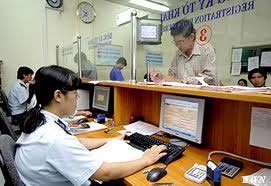Strategy to expand e-customs procedures aims for efficiency
 |
| illustration photo |
It also wants e-customs used by all provincial and district departments by the same year.
This was part of the Customs Development Strategy approved on March 25 by Prime Minister Nguyen Tan Dung.
"The strategy aims at establishing a modern customs service with sufficient and transparent mechanisms and policies," deputy general director Vu Ngoc Anh told a press conference on March 30.
"It aims to keep it simple and in harmony with international standards based on centralised data-processing and risk management," Anh said.
The strategy was achievable because it was based on the nation's growth strategy as well as the sector's development strategy, Anh said.
E-customs procedures had already been applied in 76 out of 84 branches of 13 out of 33 provincial customs departments of the sector.
Nearly 60 per cent of 17,000 enterprises nationwide and more than 50 per cent of the country's tax collection used e-customs procedures. Seven other provincial customs departments would apply e-customs procedures next year.
The strategy targeted to reduce manual checking of goods from the current rate of 15-20 per cent to under 10 per cent by 2015 and under 7 per cent by 2020.
A pilot one-stop-shop customs mechanism was currently operating for implementation in 2012. This allowed all procedures to be handled at one point, including clearances, paperwork, taxes and duties. The rate of export-imports licenced through the one-stop-shop customs mechanism would reach 50 per cent by 2015 and 90 per cent by 2020.
The customs sector had faced difficulties in implementing the e-customs system due to lack of human resources, IT infrastructure and legal policies in some areas, Anh said.
He added that the customs sector strived to speed up clearance times to those of advanced countries in the ASEAN region by 2020. At present, customs clearance times were up to three times that of advanced countries in the region.
All data would be processed centrally from 2015.
The general department said the cost of the strategy would be met from the state budget, private sector and international support.
What the stars mean:
★ Poor ★ ★ Promising ★★★ Good ★★★★ Very good ★★★★★ Exceptional
Related Contents
Latest News
More News
- Stress laid on high-quality FDI inflows (December 15, 2025 | 11:00)
- Can Tho utilises its growth advantages (December 15, 2025 | 09:09)
- Ca Mau unlocking potential to shape a more sustainable future (December 15, 2025 | 09:02)
- Major projects to be inaugurated nationwide (December 15, 2025 | 08:00)
- MoF workshop highlights mounting concerns over ODA on-lending costs (December 12, 2025 | 16:05)
- National Assembly approves pilot mechanisms to accelerate major projects in Hanoi (December 12, 2025 | 11:29)
- Legislation gives government flexibility for loan guarantees (December 11, 2025 | 18:04)
- Vietnam eases policy approval requirements, simplifies foreign and outbound investments (December 11, 2025 | 17:53)
- Vietnam masters core technologies of automobile value chain (December 11, 2025 | 17:46)
- VAL opens second line of largest soybean crushing complex in Southeast Asia (December 11, 2025 | 12:08)

 Tag:
Tag:






















 Mobile Version
Mobile Version